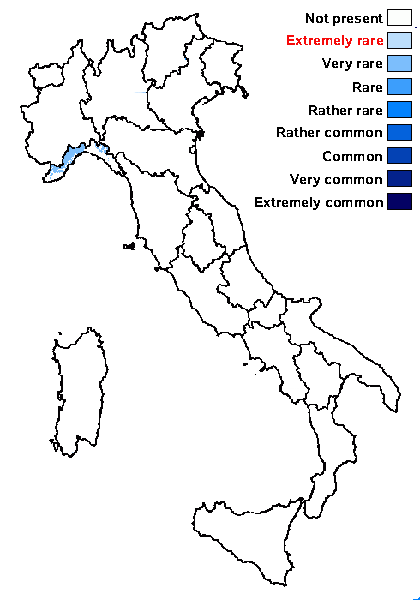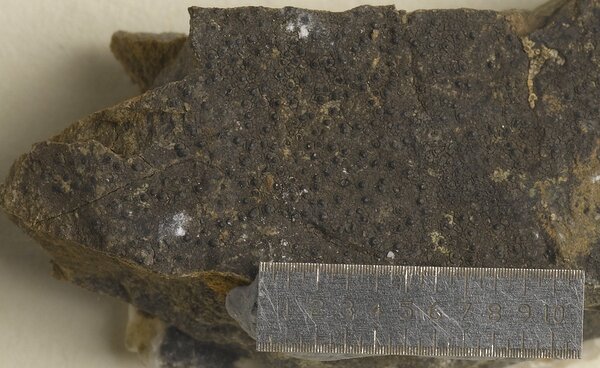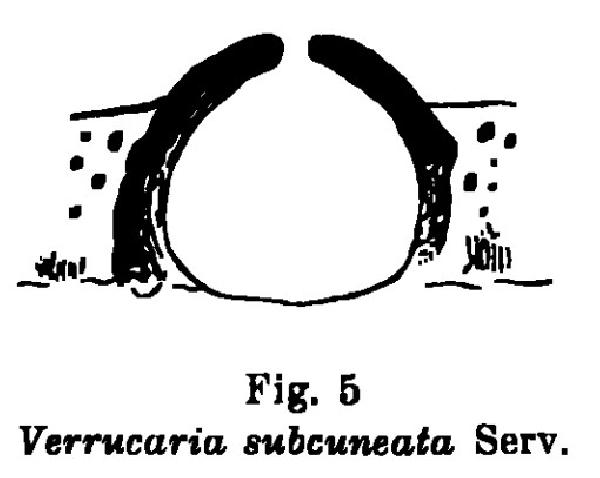Verrucaria subcuneata Servít
Webbia, 8: 417, 1952.
Synonyms:
Distribution: N - Lig.
Description: Thallus crustose, episubstratic, dull brown, 0.15-0.2 mm thick, rimose-areolate, the areoles flat, 0.2-0.8 mm wide. Cortex not differentiated, the thallus subparaplectenchymatous throughout; algal cells irregularly distributed, concentrated in the upper part of thallus. Perithecia black, 1 per areole, slightly projecting. Involucrellum black, adpressed to exciple, 30-40 µm thick, reaching down to base-level; exciple 0.2-0.25 mm across, the wall colourless to yellowish brown; hamathecium of periphyses and periphysoids measuring 20-25 x c. 2.5 µm, interascal filaments absent; hymenial gel hemiamyloid, I+ red (I+ blue at very low concentrations of I), K/I+ blue. Asci 8-spored, clavate, I-, fissitunicate, the wall thickened above, with an ocular chamber, dehiscent by extrusion of an endotunica to form a delicate rostrum, Verrucaria-type. Ascospores 1-celled, hyaline, narrowly ellipsoid, (15-)16-20(-22) x (5.5-)6-7.5(-8) µm. Photobiont chlorococcoid. Spot tests: K-, C-, KC-, P-, UV-. Chemistry: without lichen substances.Note: according to Breuss (2016) this poorly known species, described from Val Bisagno near Genova, is also present in the Alps of Austria and Germany. Ecological indicator values are tentative: from the scanty available information the species seems to grow on calciferous rocks in rather shaded situations, such as in forests.
Growth form: Crustose
Substrata: rocks
Photobiont: green algae other than Trentepohlia
Reproductive strategy: mainly sexual
Poorly known taxon in need of further study
Commonnes-rarity: (info)
Alpine belt: absent
Subalpine belt: absent
Oromediterranean belt: absent
Montane belt: very rare
Submediterranean belt: very rare
Padanian area: absent
Humid submediterranean belt: absent
Humid mediterranean belt: absent
Dry mediterranean belt: absent

Predictive model
Growth form: Crustose
Substrata: rocks
Photobiont: green algae other than Trentepohlia
Reproductive strategy: mainly sexual
Poorly known taxon in need of further study
Commonnes-rarity: (info)
Alpine belt: absent
Subalpine belt: absent
Oromediterranean belt: absent
Montane belt: very rare
Submediterranean belt: very rare
Padanian area: absent
Humid submediterranean belt: absent
Humid mediterranean belt: absent
Dry mediterranean belt: absent

Predictive model
 INDEX FUNGORUM
INDEX FUNGORUM
 GBIF
GBIF



